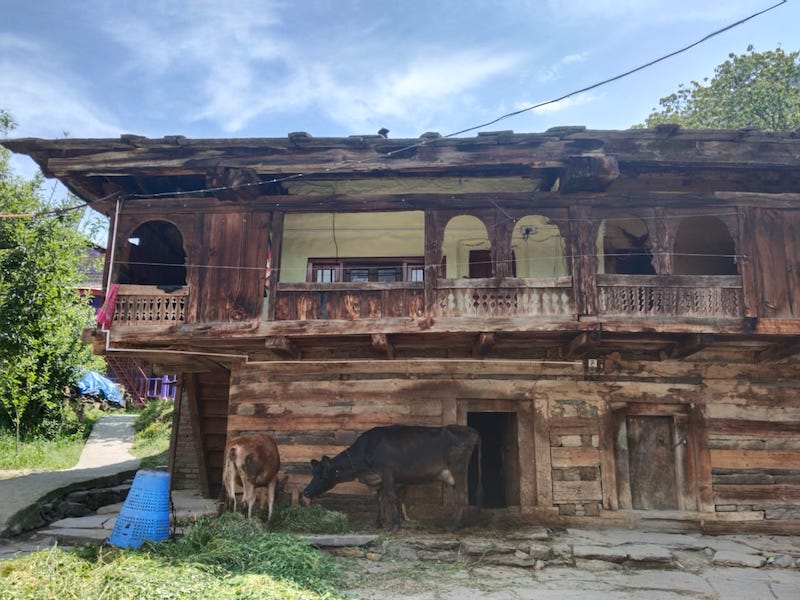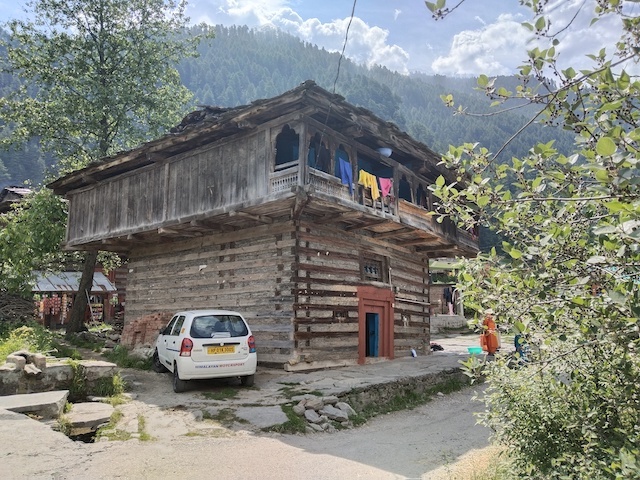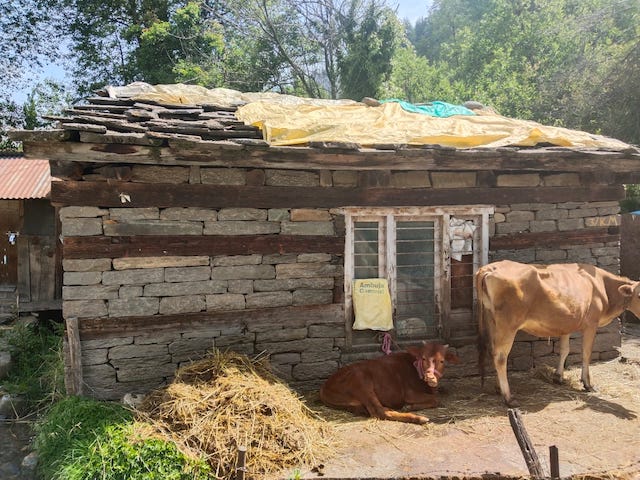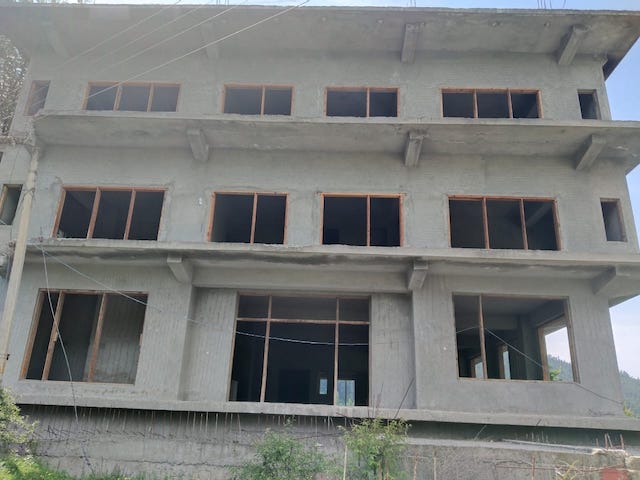Kullu valley traditional building techniques were long forgotten. Now, there is a determined effort to gather ancient wisdom and place it in the present context.
An earthquake that jolted Kullu region way back in1905 came with a preliminary tremor followed by three separate shocks. The epicenter in Kullu valley was at Larji, but the loss of human life here nowhere reached the same proportion as in other regions of the state, which was due to the better style of house-building prevalent in the region of the state.
The timber-bonding in the houses held them together long enough, in most cases, for the inmates to escape. In Kullu region a few hundred died. In parts where the “Kullu type of architecture was not in fashion”, losses were too huge to be counted. Kullu, home to the erstwhile king, and Larji saw absolute devastation. But at nearby Banjar, the region, the treasury, thana and hospital were all timber-bonded and escaped with little damage. So did the castle at Naggar, having much wood in its construction. In Spiti, the houses, built of mud with twig roofs, suffered considerably, but no loss of life was reported.

A century on, that traditional building technique Kathkuni finds few takers. And why just Kathkuni, from Kullu brick and wood roofs to the mud houses in Spiti and Kangra, traditional structures have been rapidly demolished and replaced by homogenous concrete structures. Attempting to foil degeneration are some institutions and individuals who are trying to make people understand the importance of traditional practices in architecture, while keeping in step with technology.A kathkuni structure resort being made in Kullu district.
Chhavinder Thakur resident of Kullu valley hails from Kanyal village of Manali sub division said that he was perhaps the first to make people aware of what they were losing out on. However, he also incorporated modern technology to make structures sturdier while keeping them rooted in the environment from which they evolve. He wondered why people were going backwards towards a mud house when everyone around was moving forward and embracing pucca houses. The resident was to soon learn the beauty of traditional material, the role of sun and air, the ecological cost of carbon footprint.

“Traditional Kullu homes are mud walls and stone roofs, but at the time he came here, most of us were in the process of tearing down old homes and replacing them with concrete structures and tiled floors,” Thakur said. The people would tell him that they have no right over a deodar tree, which has taken 1,000 years to reach where it is today. He guided people that they should go for other varieties like kayal and rai.”
Architect Duni from Manali took to natural materials once he understood the consequences of modern building materials. He says natural materials pollute less in their manufacturing process and leave less waste when a building is demolished. Industrial material is used, but thoughtfully. “Since Kullu falls in seismic zones 5 and 4, making it highly prone to earthquakes of destructive intensity, we need ring beams at different levels in the building — plinth beam, lintel beam and in the foundation to connect the entire periphery of the building. Earlier this was made from wood, but now we use concrete. At times, I-girders are used in the rooms if the client wants a bigger room because the wooden planks in the market do not measure more than 10 feet,” he says.

Dhuni says if a person is building a home from natural material on a 3 to 5 biga plot, most requirements of mud and stones will be met from the land itself, reducing the carbon footprint to a minimum or zero. He added that since a natural home employs renewable resources the waste doesn’t go into a landfill. Aesthetics and emotional connect apart, these materials regulate internal temperature, keeping homes warm in winters and cooler in summers. They regulate humidity and absorb sound too. The high temperatures in Kullu valley this year are all the more reason why one should go in for traditional architecture, insists Dhuni.
And there are takers. With the need to connect with nature felt severely during the Covid pandemic, many are turning to natural living. The urge to dish out something new to people has also led the tourism industry to experiment, says Chandan Sharma from nagger, who realised this close to two decades ago and added elements of Kathkuni to his cottages in Kullu’s scenic Naggar village. At Naggar panchayat’s newest tourist hub Jana, Chandan dismantled his old Kathkuni house a few years ago. In its place now stands a Kathkuni resort. He reused most of the stones and wood from the old building where roofs were constantly leaking during rains.
The more than 550-year-old Naggar castle, a heritage hotel, stands tall a 100 years after the quake, the wooden beams a particular distance apart, in a fashion that modern architects have given a new name: a “Lego-like” structure. This is Kathkuni for you, the word literally meaning wood (kath) at the corners (kuni). Sharma says a typical Kathkuni building is one layer of stone followed by one layer of wood above the foundation, held together without mortar or metal nails. The logs are interlocked through wooden braces or joints. “Nails come off during a quake, but the wooden joints take back their place.”

Interestingly, Kullu valley today is a curious mix of old and new Kathkuni structures. While the landscape is dotted with concrete homes, it is easy to spot a flashy new Kathkuni resort or home. The old ones are dilapidated, hinting at the economic status of the family that owns it. The glaring time gap owes itself to the market-driven idea of house building.
Architect Dhuni said that this gap also owes itself to a lack of experts who could explain to people the need to stick to the roots. “Our temples like Hadimba mandir in Manali have survived for centuries. And from Kinnaur to Kullu, as also Istanbul and Switzerland, indigenous construction practices have been similar because these emanated from our roots. And we are talking about times when there were no means of communication.”
“Traditional architecture is a natural reflection of our culture, and which is why houses in Kerala look so different from houses in Rajasthan and houses in Spiti different from those in Punjab. These houses use local materials suiting local climatic context. And we are not just losing the buildings but also the knowledge that goes into making them.” However, the seismic vulnerability of Spitian homes remains a concern.
Also, depleting forests is a huge concern. Chandan says the government gives loans for a concrete house, but not for a mud house. Perhaps it is time for collective thinking in this direction.
Attention to traditional practices that sustained the environment in the past over a long period of time can offer clues toward sustaining architecture for the future. Traditional architecture usually rests on people’s observation of nature. Ultimately we depend on nature, and so destroying nature is ultimately destructive to us. We have to work now to re-establish our dialogue with nature, and with the past, if we are going to have a future.
Kathkuni is labour-intensive, raising daily wages of a mason by 20 per cent as compared to a mason employed in RCC construction.
While construction material is already costly in the hills, transport costs add to it, increasing cost of RCC construction by 30 to 35 per cent than in the plains. Wood is an expensive proposition and building a traditional home means using lots of it.

Sanjay Dutta, an engineer by qualification but is a journalist by choice.
He has worked for the premier new agency Press Trust of India and leading English daily Indian Express.
With more than a decade of experience, he has been highlighting issues related to environment, tourism and other aspects affecting mountain ecology.
Sanjay Dutta lives in a village close to Manali in Kullu valley of Himachal.


